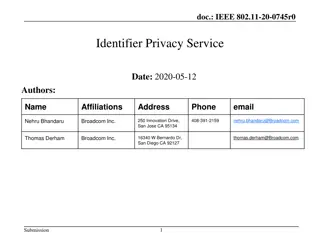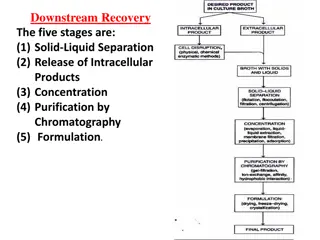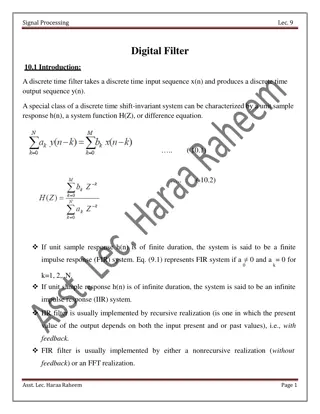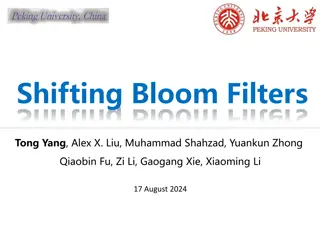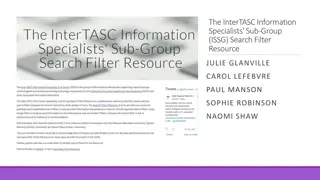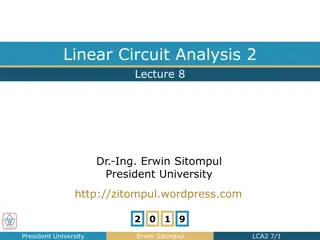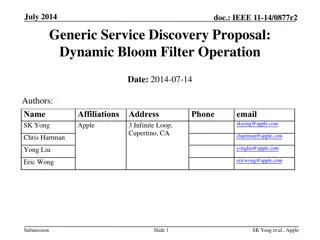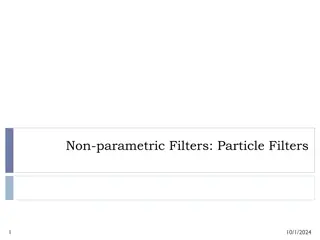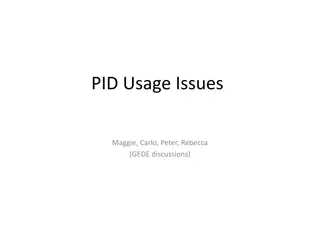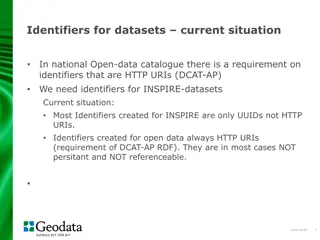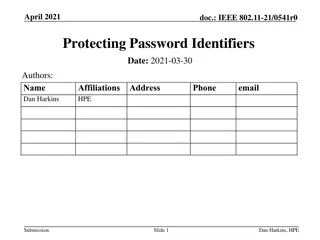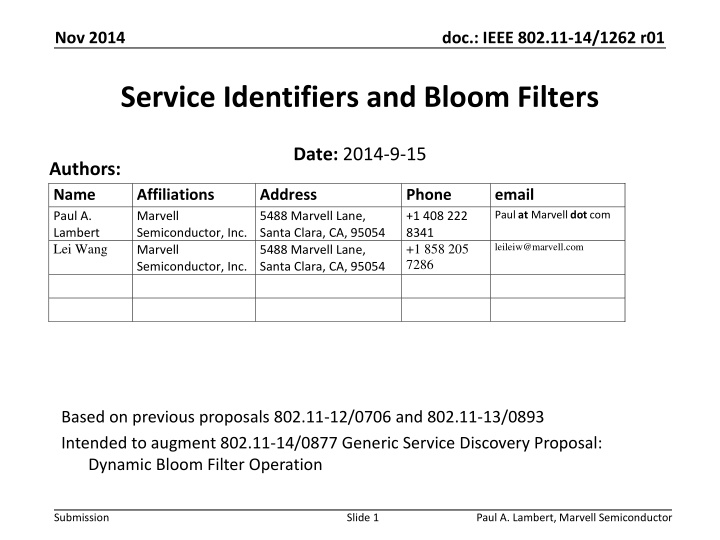
Efficient Service Discovery and Identifiers in IEEE 802.11 Standards
Explore the presentation slides discussing the efficient definition and discovery of service identifiers in IEEE 802.11 standards, focusing on Bloom filters, unique identifiers, and privacy mechanisms. The content delves into the importance of service knowledge for device communication selection and the various ways to define application-level services for interoperability and unique identification, offering insights into mapping services to unique identifiers.
Download Presentation

Please find below an Image/Link to download the presentation.
The content on the website is provided AS IS for your information and personal use only. It may not be sold, licensed, or shared on other websites without obtaining consent from the author. If you encounter any issues during the download, it is possible that the publisher has removed the file from their server.
You are allowed to download the files provided on this website for personal or commercial use, subject to the condition that they are used lawfully. All files are the property of their respective owners.
The content on the website is provided AS IS for your information and personal use only. It may not be sold, licensed, or shared on other websites without obtaining consent from the author.
E N D
Presentation Transcript
Nov 2014 doc.: IEEE 802.11-14/1262 r01 Service Identifiers and Bloom Filters Date: 2014-9-15 Authors: Name Paul A. Lambert Lei Wang Affiliations Marvell Semiconductor, Inc. Marvell Semiconductor, Inc. Address 5488 Marvell Lane, Santa Clara, CA, 95054 5488 Marvell Lane, Santa Clara, CA, 95054 Phone +1 408 222 8341 +1 858 205 7286 email Paulat Marvelldotcom leileiw@marvell.com Based on previous proposals 802.11-12/0706 and 802.11-13/0893 Intended to augment 802.11-14/0877 Generic Service Discovery Proposal: Dynamic Bloom Filter Operation Submission Slide 1 Paul A. Lambert, Marvell Semiconductor
Nov 2014 doc.: IEEE 802.11-14/1262 r01 Purpose of Presentation Provide clear definitions to support generic service discovery using truncated hashes Provide basic privacy mechanisms for service identifiers Define fully unique service identifiers in addition to efficient short nearly unique identifiers Define efficient procesing and algorithms for identifiers Define efficient Bloom Filter hashing Introduce more efficient Bloom Filter to trade-off discovery time against frame sizes Submission Slide 2 Paul Lambert, Marvell
July 2013 doc.: IEEE 802.11-14/1262 r01 What is a Service? For IEEE 802.11, knowledge of services supported by a device help in the selection of the appropriate STA/AP for subsequent communications Examples might include: Finding the right AP to connect to a print service Finding a near-by WLAN supporting a particular application Find a network (AP) with appropriate network connectivity and services for a particular set of applications Find a AP/STA that can reach a particular application and user Submission Slide 3 Paul Lambert, Marvell
July 2013 doc.: IEEE 802.11-14/1262 r01 On Services There are many different existing ways to define application level services, possible examples include: UPnP, Bonjour, XML, OIDs, OUI fields, Bluetooth ids, URLS, Wi-Fi Alliance types (e.g. WFD), etc. Some of the above can be very large (e.g. UPnP) Many different organizations want to control and register identifiers to ensure interoperability (they want a single rooted hierarchy) Rapid growth of new mobile applications requires a simple process to ensure unique identification from many different organizations. Submission Slide 4 Paul Lambert, Marvell
July 2013 doc.: IEEE 802.11-14/1262 r01 Mapping services to a unique identifier Most identifiers are made unique by creating hierarchies that are controlled by a central authority with sub branches delegated within a limited name space (e.g. DNS names and IANA) A powerful alternative is to define identifiers within a very large address space where the address space is so large that every identifier is guaranteed to a very high probability to be unique 16 octets can define a very large address space (2^128) to provide unique identifiers and is actually shorter in octets than most hierarchical naming schemes A hash function can be used to define a process for the creation of unique identifiers Very large set of possible identifiers. Used identifiers are a very small set within name space Submission Slide 5 Paul Lambert, Marvell
July 2013 doc.: IEEE 802.11-14/1262 r01 Cryptographic Hash Functions A hash takes a block of data and returns a fixed size octet string such that any change in the data has a high probability of changing the hash value (aka digest) A good cryptographic hash function has the property that it is infeasible to generate a message for a given hash Examples of well known cryptographic hash functions include: MD5, SHA-1, SHA-256 http://en.wikipedia.org/wiki/Cryptographic_hash_function Submission Slide 6 Paul Lambert, Marvell
July 2013 doc.: IEEE 802.11-14/1262 r01 Very Big Numbers Astronomy has long been humanity's go-to subject when it comes to contemplating the truly enormous. But actually, if 2128 is so much more vast than the number of stars in the observable universe (1015 times more vast*, or 4,000,000,000,000,000 in long-hand notation), then even the name "astronomical" is rather inadequate. -- from Economist http://www.economist.com/blogs/johnson/2011/01/big_numbers Submission Slide 7 Paul Lambert, Marvell
Nov 2014 doc.: IEEE 802.11-14/1262 r01 Process to define Service Identifiers Any group can get together and define a service. They should make sure that they have unique names. Definition of foo Service Name Definition of bar Service Name Each service needs to define an appropriate string (text or octets) to define there service A cryptographic hash is used to create a unique identifier and may be a truncated version of the full hash Hash Function Hash Function foo Service Id bar Service Id Resulting identifiers are unique and any device that recognizes the identifier will have knowledge of it s usage Submission Slide 8 Paul Lambert, Marvell
Nov 2014 doc.: IEEE 802.11-14/1262 r01 Definitions for Generic Service Discovery Service Name an octet string created by the developer of the service that provides a unique identification of the service. For unprotected services, the octet string is human readable. Unique Service Identifier (USID) the first 128 bits of the SHA- 256 hash of an octet string identifying the service (Service Name). Service Id (SID) An identifier formed by truncating a Unique Service Identifier (USID). Usually truncated to 6 octets. 6 octets (48 bits) is a convenient size for a Service Id in IEEE 802.11 applications. Submission Slide 9 Paul Lambert, Marvell
Nov 2014 doc.: IEEE 802.11-14/1262 r01 USID and UUIDs A USID (Universal Service Identifier) is a type of UUID (Universally Unique Identifier) UUIDs are: 16-octet (128-bit) numbers Defined by ISO/IEC 11578:1990, X.667, ISO/IEC 9834-9:2005 and RFC 4122 Note that RFC 4122 uses SHA-1 which is no longer recommended for new applications USID as defined herein: Are 16-octet (128-bit) numbers Based on SHA256 hash Submission Slide 10 Paul Lambert, Marvell
Sept 2014 doc.: IEEE 802.11-14/1262 r01 Service Identifiers Service Identifiers are a short form of a USID that provide an efficient representation of a service (e.g. 6 octets) Service Identifiers are unique enough for discovery, but any secure usage or authentication can readily use the full USID in any integrity of authentication checks. Submission Slide 11 Paul Lambert, Marvell
May 2012 doc.: IEEE 802.11-14/1262 r01 Unique Service Identifiers vs. Service Identifiers Unique Service Identifier (USID) 128 bits long (16 octets) is large enough to be statistically unique (3E+38) is a type of UUID , a well defined construct in other standards activities Service Identifier (SID) Provides a convenient short identifier (e.g. 6 octets) May not always be unique, there may be collisions. Collisions, however, can be very rare for well selected sizes and collision impact can be mitigated Multiple Service Identifiers can be created from the same Unique Service Identifier by taking different ranges for the truncation (e.g. First 6 octets, next 6 octets ...) Submission Slide 12 Paul Lambert, Marvell
Nov 2014 doc.: IEEE 802.11-14/1262 r01 Service Id (SID) and Privacy A Service Id is opaque, it is not human readable Commonly used Service Ids would be readily identifiable by usage Service Ids can be masked by mixing the hash proces with a group key. E.g Masked Service Id = Hash(group key, service name)[0:6] This provides some privacy of service discovery and use hidden for defined private groups Submission Slide 13 Paul Lambert, Marvell
Nov 2014 doc.: IEEE 802.11-14/1262 r01 Bloom Filters and Service Ids Bloom filters offer a means to efficiently indicate membership of a large number of items. IEEE 11-14/0877r2 Generic Service Discovery Proposal: Dynamic Bloom Filter Operation Bloom filters need k hash calculations to map a service into k bits of a vector of length m in bits A USID, SID or any hash based UUID already has created a large strong hash to create the indenters This larger hash can be reused to provide and efficient processing of multiple bloom hash calculations Submission Slide 14 Paul Lambert, Marvell
Nov 2014 doc.: IEEE 802.11-14/1262 r01 Proposed Bloom Hash Calculations Assuming that USID is formed as: USID = SHA256(service_name) or USID = SHA256(service_name)[0:16} truncated to 16 octets (128 bits ) The bloom filter is of length m in bits k hashes are required for the filter Each bloom hashi (for i 0 to k-1) is calculated as: 16 bit little-endian Integer value of SHA256(service_name)[2*i:2*(i+1) modulo m The above is just the hash taken two bytes at a time mapped (modulo m) into the bit vector as an index of the bit to set. The SHA256 value or USID is simply retained for a service and is NOT calculated on each usage Submission Slide 15 Paul Lambert, Marvell
Nov 2014 doc.: IEEE 802.11-14/1262 r01 Proposed Efficient Bloom Hash Calculations Use portions of USID as integer index Each 0-to-k bloom calculation is simply a portion of the existing hash treated as an integer. Very efficient calculation: The USID is retained for a service and is NOT calculated on each usage H1 = USID[0:2] mod m <- use portion of prior hash H2 = USID[2:4] mod m Etc... When m is power of 2, very simple hash calculation Can be extended to any size k Submission Slide 16 Paul Lambert, Marvell
Nov 2014 doc.: IEEE 802.11-14/1262 r01 Small Example USID, SID and Bloom Hash Service Name: service.name.example SHA256: e3b0c44298fc1c149afbf4c8996fb924 27ae41e4649b934ca495991b7852b855 USID: e3b0c44298fc1c149afbf4c8996fb924 SID: e3b0c44298fc Bloom Filter Hash Calculation(m=128bits k=3) H0 -> e3b0 to int-> 45283 mod 128 -> 227 H1 -> c442 to int-> 17092 mod 128 -> 196 H2 -> 98fc to int-> 64664 mod 128 -> 152 Bloom Filter (in hex): 00000008000000100000000001000000 00000000000000000000000000000000 Submission Slide 17 Paul Lambert, Marvell
Nov 2014 doc.: IEEE 802.11-14/1262 r01 Full Example and Test Vectors service name: service.name.example hash value: 64e5f1506840684457cb04a25214fbea8311f893b6478961ba4202bb8699c9b4 usid: 64e5f1506840684457cb04a25214fbea usid b27: JEQGFF4M7HBFQNH3CKYEQMMX666 service id: 64e5f1506840 service id b27: RR3XJ49JPJ max n: 512 p: 0.0015 bloom id m=6936 k=9: (867 octets long) 000000000000000000000200000000000010000000000000000000000000000000000000000000000000000000000000000000000000000000000000000000000000 000000000000000000000000000000000000000000000000000000000000000000000000000000000000000000000000000000000000000000000000000000000000 000000000000000000000000000000000000000000000000000000000000000000000000000000000000000000000000000000000000000000000000000000000000 000000000000000000000000000000000000040000000000000000000000000000000000000000000000000000000000000000000000000000000000000000000000 000000000000000000000000000000000000000800000000000000000000000000000000000000000000000000000000000000000000000000000000000000000000 000000000000000000000000000000000000000000000000000000000000000000000000000000000000000000000000000000000000000000000000000000000000 000000000000000000000000000000010000000000000000000000000000000000800000000000000000000000000000000000000000000000000000000000000000 100000000000000000000020000000000000000000000000000000000000000000000000000000000000000000000000000000000000000000000000000000000000 000000000000000000000001000000000000000000000000000000000000000000000000000000000000000000000000000000000000000000000000000000000000 000000000000000000000000000000000000000000000000000000000000000000000000000000000000000000000000000000000000000000000000000000000000 000000000000000000000000000000000000000000000000000000000000000000000000000000000000000000000000000000000000000000000000000000000000 000000000000000000000000000000000000000000000000000000000000000000000000000000000000000000000000000000000000000000000000000000000000 000000000000000000000000000000000000000000000000000000000000000000000000000000000000000000000000000000000000000000000000000000000000 000000000000000000 Submission Slide 18 Paul Lambert, Marvell
Nov 2014 doc.: IEEE 802.11-14/1262 r01 Bloom Filter Problems They are long Do we really want 800+ octets in every beacon? Probability could be lowered ... But then false positives become a problem Submission Slide 19 Paul Lambert, Marvell
Nov 2014 doc.: IEEE 802.11-14/1262 r01 Sequential Bloom Filters Shorter Bloom Filters are possible with the same probability ... If we send multiple different filters Define r filters of length l where sum of length of the r filters is m Effectively trading time (multiple filters in beacons for length) Example: Rather than one 800 octet filter, send 4 100 octet filters Each filter processed separately If desired service is not found in any filter part search can stop Probability incrementally increases with each filter part processed. Possible to have very low false positive probability and shorter transmitted frames Submission Slide 20 Paul Lambert, Marvell
Nov 2014 doc.: IEEE 802.11-14/1262 r01 Efficient Sequential Bloom Calculations For: m bit filter, desired false positive p , r sequential bloom filters, and k bits set in filter for desired p for n_max services r Bloom filters are sent sequentially ( BF0, BF1, .. BFi, . BFr-1 ) Sum of length of each BFi is m Very efficient processing for each Bfi is possible by: For a desired Bloom Id, maintain the k index values as an ordered list. (I0, I1, .. Ii, . Ik-1 ). Any BFican be efficiently processed knowing i sequence index by mapping the range of index values into the ith filter This processing approach is effectively chopping one m-bit filter into r pieces of m/r length. False positive p still obtained, but after r samples of BFi Submission Slide 21 Paul Lambert, Marvell
Nov 2014 doc.: IEEE 802.11-14/1262 r01 Privacy and Bloom Filters Bloom filters can provide privacy http://arxiv.org/pdf/1407.6981v2.pdf A unknown Bloom Id is very hard to identify when mixed with other Bloom Id or random bits in a Bloom Filter A known service can be identified The masked Service Ids could have corresponding Masked Bloom Ids This implies that efficient processing of hashing process should base the Masked Service Id on a Masked Service Name or Masked USID Submission Slide 22 Paul Lambert, Marvell
Nov 2014 doc.: IEEE 802.11-14/1262 r01 Definition of Terms Service Name A string value that uniquely identifies a service. This can be a Bonjour, DLNA or other types of identifiers. Masked Service Name A transformation of a Service Name used to generate a different Service Id to obfuscate the identification of a service. Universal Service Id (USID) A 128-bit unique identifier for a Service Name based on a hash of the Service Name. Service Id (SID) A 6 octet mostly unique identifier for a service. It is based on a hash of the Service Name. Bloom Id A 'm' bit long bit vector representing the Service Name. This bit vector is based on a hash of the Service Name that maps into a small number of bits (k bits) in the m-bit vector. Bloom Filter Multiple Bloom Ids ORed together to represent a set of Bloom Ids. A Bloom Filter can be readily tested to determine if it contains a specific Bloom Id. False positive probability 'p' is estimated as p = (1-e**(-k*n/m)))**k for optimally selected k. k should be selected for maximum planned value of n Submission Slide 23 Paul Lambert, Marvell


